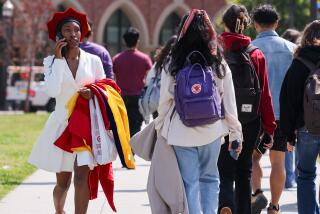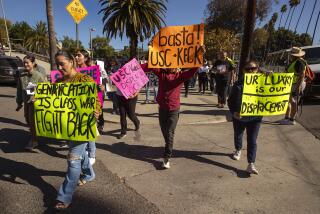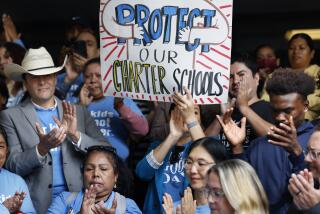North County Campus Autonomy From SDSU Urged
- Share via
The new state university campus in San Marcos should immediately sever ties with its mother campus, San Diego State University, and forge ahead independently as the state’s 20th university campus, a subcommittee of trustees recommended Tuesday in Long Beach.
Their suggestion, which will now go to the full board of trustees of the California State University system for action next month, stunned local boosters of the campus, who lobbied for the San Marcos campus to remain under the wings of San Diego State University and draw on its reputation as arguably the system’s flagship campus in order to better recruit faculty, secure funding and develop programs.
Instead, the subcommittee voted 4 to 1 to agree with Chancellor W. Anne Reynolds’ recommendation that California State University, San Marcos, be established as quickly as possible, with its own administration charged with hiring a faculty and developing programs on its own.
Role for Legislature
If the full board agrees Nov. 16 with the subcommittee’s decision, the debate would then move to Sacramento, for requisite state legislation.
The San Marcos campus is scheduled to open in the fall of 1992 to upper-division and graduate students on a new, 300-acre campus in San Marcos. In 1995, the campus would evolve into a full-service, four-year university, and by the year 2020 it is expected to have upwards of 20,000 students, drawn primarily from North County but also from southern Riverside and Orange counties.
San Diego State University began offering courses in North County in 1979, first operating a small campus in Vista before moving to leased offices in San Marcos that currently accommodate about 2,000 students in upper-division and graduate courses.
Lee Grissom, president of the Greater San Diego Chamber of Commerce and a state university trustee who sat on the subcommittee, opposed the decision to cut ties with SDSU. He contended the issue boiled down to who would ultimately control the development of the new campus--Reynolds or San Diego State University President Thomas Day.
Said Grissom: “Ann Reynolds says, ‘This is the first new campus in 22 years and I wasn’t chancellor 22 years ago and I want to be the parent who oversees the birth of this institution.’ Tom Day says, ‘Look, for 10 years we’ve been working towards this and the very reason we’re addressing the issue today is because we’ve been very successful in nurturing the (North County satellite campus). We’ve made a strong commitment to its quality and its existence.’
Concern Over Centralization
“The other trustees are very concerned about form and structure and increasing the centralization of authority and power in the Long Beach headquarters,” Grissom said.
But Marianthi Lansdale, chairman of the board of trustees who also sat on the ad-hoc committee, said she saw the issue differently.
“This is an exciting new adventure,” she said. “I don’t know what’s to be gained by keeping it under San Diego’s umbrella. This isn’t just a San Diego project, but one that affects Orange County and Los Angeles County as well. I know this institution will be able to stand on its own and will be a fine campus. It’s in the fastest growing area of the state and will attract some fine faculty there.”
Reynolds told the subcommittee the there was a need “to have leadership for the new campus as early as possible to provide educational direction, a spokesperson in budget support, and an administration wholly accountable for academic and physical planning.”
Linking the San Marcos campus to San Diego State University would be counterproductive, she said.
“The fact remains that an administration and faculty which is responsible for a mature, reputable university on the one hand, and for planning and nurturing a new entity which could ultimately challenge the older one, will have divided loyalties despite the best of intentions,” she said.
“This is not a matter of who should be in control. The issue before us . . . (is) what is the best process for developing a unique and dynamic university which is not a clone or extension of an existing campus, but rather greatly enhances the system as a whole,” she said.
Reynolds said there was also administrative concern that if SDSU operated the San Marcos campus and assigned faculty there, those professors could later decide to “retreat” back to San Diego--a request that the university would be bound contractually to honor--once the university in San Marcos ultimately broke off on its own.
‘Ultimate Loyalty’
Rather than raise the issue of “ultimate loyalty” of SDSU faculty, it would be better, Reynolds said, for San Marcos to be independent and autonomous from the start.
“A president and his or her cadre of academic administrators and school deans must set the standards and tone for a new campus,” Reynolds said. “The challenge of a new institution located in one of this country’s most attractive regions should and will attract highly qualified faculty of all ages, experience and ethnicity.”
All but Grissom--himself an SDSU alumnus--were won over by Reynold’s argument.
“I have more knowledge as to what’s happening in North County than they do, and I think I have a clearer understanding of what that campus will need to be a full-blown, dynamic intellectual unit than they do,” Grissom said.
“I think we’re running the risk of hurting the campus’ development. If we go with this model, it will grant independence to the campus as soon as possible; we’ll hire a president and four or five vice presidents and then the deans of the various schools--and we won’t have any students yet since San Diego State will continue to operate its satellite office,” Grissom said.
Day said he had “mixed feelings” about Tuesday’s decision and said he could live with it if the full board of trustees agrees with its committee’s recommendation.
“Our main argument was that in starting off, it would be useful to have economics of scale and an excellent faculty to help with initial decisions” for the new campus, Day said.
Comment by Day
“It’s my own individual best judgment that it’s better to stay with San Diego State for a while, but going independent immediately was a defensible judgment call and it could work. We will support it,” Day said.
But state Sen. Bill Craven (R-Carlsbad), who shepherded the legislation authorizing the purchase of the San Marcos campus site, was less ambivalent.
“I don’t understand their rationale,” Craven said. “They’ve determined how they want it to be and couched their arguments accordingly. They have paid absolutely no attention to the sentiment which has arisen out of the area to be served.”
Carol Cox, an administrative aide to Craven who has worked intensely on the San Marcos campus development, said she had myriad concerns--including how speedily the new university could be accredited if it is forced to start fresh.
“We will have no reputation, no core faculty, no foundation that will help recruit faculty,” said Cox, who said the new university could be likened to a handicapped newborn.
“There is a growing shortage of professors around the nation and what faculty that is available will be looking for the best possible place for themselves, and will be able to shop around,” Cox said. “As a new university, we won’t be able to compete with that.”
But Lee Kerschner, vice chancellor for academic affairs for the state university system, said accreditation would not be a problem for the new campus. “The Western Assn. of Schools and Colleges has assured us they’ll work closely with us,” he said. “At no time will students be without an accredited degree.”
The new campus would have to be accredited by the accreditation body even if it were to remain under SDSU’s wings, he said.
And he argued that the new campus would be in a better position of strength in getting financing than it would if it remained tied to SDSU.
If the San Marcos campus were linked to SDSU, he said, the mother campus in San Diego “would be in the awkward position of recruiting against itself and in setting capital outlay priorities that might work against itself at its main campus.”
And bureaucratically, it would be simpler to divide the two campuses now than later, he added.
“The further along you go in this process (of San Marcos being governed by SDSU), the more difficult it becomes to disentangle all the relationships, whether it be faculty, admissions and records, the bookstore, whatever. The longer you wait, the more complicated the unwinding becomes. At some point, it must be separated, and it’s easier to do that immediately.”
A whole host of North County civic and business leaders had argued that the San Marcos campus remain under SDSU’s umbrella, and some said Tuesday’s decision will come back to haunt the fledgling campus.
“It’s going to be very difficult to avoid stunting the new campus unless it remains under the protective wing of the SDSU main campus,” said Ken Lounsbery, spokesman for a North County advisory council which addressed the issue and argued strongly that the two campuses remain as one for at least five years.
“Obviously, everyone in North County is delighted by the thought of having an independent campus, but we’re also mature enough to realize the action of the trustees’ ad-hoc committee was a disappointment. We supported the evolutionary independence of the North County campus.”
Grissom said he held little hope that the full board of trustees would overrule the subcommittee’s recommendation next month.
More to Read
Sign up for Essential California
The most important California stories and recommendations in your inbox every morning.
You may occasionally receive promotional content from the Los Angeles Times.










